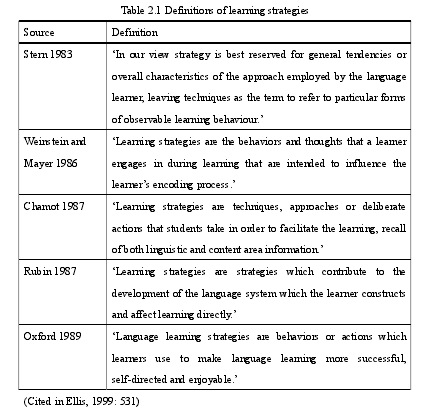联系方式
more本类最新英语论文
- 2024-04-05批判性思维能力对高中生英语..
- 2024-03-29自我效能感与专科生英语学习..
- 2024-02-24基于课堂教学观察的高中英语..
- 2024-01-24运用元认知策略提升初中生英..
- 2024-01-02面向深度学习的高中英语单元..
- 2023-12-26多模态教学对初中生英语听力..
- 2023-12-15干预式动态评价对初中生英语..
- 2023-12-03pace模式推广于初中英语语法..
- 2023-11-28基于最近说服能力区理论的同..
- 2023-11-16基于语料库的高中英语写作错..
more热门文章
- 2016-01-11学习者用母语在第二外语教学..
- 2011-01-25co-operative education:d..
- 2012-03-06影响英语学习的因素the fac..
- 2010-03-12an empirical study of cal..
- 2012-11-23定性分析认知语言学中的意象..
- 2010-04-06探讨英语口语教学的有效途径
- 2011-01-18英语论文网:教学大纲a fra..
- 2012-05-10task-based language teach..
- 2010-03-22利用网络电脑功能提高翻译质..
- 2014-05-26中学英语教学中跨文化意识的..
more留学论文写作指导
- 2024-03-31卡森•麦卡勒斯小说中..
- 2024-03-28美国黑人女性心理创伤思考—..
- 2024-03-27乔治·艾略特《织工马南》中..
- 2024-03-21超越凝视:论《看不见的人》..
- 2024-03-19《哈克贝利•费恩历险..
- 2024-03-13心灵救赎之旅——从凯利的三..
- 2024-02-22文学地理学视角下的《印度之..
- 2023-05-03英、汉名词短语之形容词修饰..
- 2023-02-07目的论视域下5g—the futur..
- 2022-07-04二语英语和三语日语学习者的..
非英语专业学生的歧义容忍度和语言学习策略研究 [3]
论文作者:www.51lunwen.org论文属性:硕士毕业论文 thesis登出时间:2016-02-18编辑:lgg点击率:5428
论文字数:38569论文编号:org201602171305023922语种:英语 English地区:中国价格:$ 66
关键词:英语教学法论文非英语专业大学生歧义容忍度语言学习策略
摘要:本文是英语教学法论文,本文的目的在于调查中国非英语专业大学生的歧义容忍度和语言学习策略使用的概况及探索二者的关系,发现他们在英语学习过程中普遍存在的问题,然后找到合适的策略来解决这些问题。

.........
Chapter 3 Methodology .......21
3.1 Subjects ......21
3.2 Research Questions ........21
3.4 Procedures ........23
3.4.1 Pilot Test.........23
3.4.2 Data Collection .....24
3.5 Data Analysis ....24
Chapter 4 Results and Discussion.....25
4.1 Characteristics of the Subjects’ Tolerance of Ambiguity....25
4.2 Characteristics of Subjects’ Language Learning Strategies......30
4.4 Correlation between TOA and the Selection and Application of LLS....41
Chapter 5 Conclusion ..........45
5.1 Major Findings of the Present Study........45
5.2 Research Limitations and Suggestions for Future Research.....49
Chapter 4 Results and Discussion
This chapter presents and discusses the results of this study and attempt toexplain the results. It includes the following aspects: characteristics of the subjects’TOA and LLS, differences between high tolerance of ambiguity subjects and lowtolerance of ambiguity subjects in their language learning use, and correlationbetween tolerance of ambiguity and language learning strategies use.
4.1 Characteristics of the Subjects’ Tolerance of Ambiguity
4.1.1 Overall profile of Students’ Tolerance of Ambiguity
According to their scores of tolerance of ambiguity, the author divided 285subjects into high tolerance of ambiguity group and low tolerance of ambiguity group.The number of high tolerance of ambiguity subjects is 48, accounting for 16.84%, andthe number of low tolerance of ambiguity subjects is 237, accounting for 83.16%,shown as follows.The percentage of high tolerance of ambiguity group, 16.84%, is slightly lessthan Zhang’s (2004) findings, whose research shows that the number of high toleranceof ambiguity subjects accounts for 18.84% and the number of low tolerance ofambiguity students is 81.16%.To get a overall picture of tolerance of ambiguity, descriptive statistics wasemployed by SPSS 16.0. A summary of the descriptive statistics results of tolerance ofambiguity is presented in Table 4.2。The results in Table 4.2 show that the mean is 2.48 (S.D. = 0.804, N = 285). Thisscore is around the median, showing that the subjects’ general degree of TOA isneither high nor low. This indicates that students in this study neither have enoughhigh tolerance of ambiguity to acquire new language easily and nor have highintolerance of ambiguity to impede their language learning.
........
Conclusion
The previous discussions of the present study have an deep influence onlanguage teaching and learning. First of all, this chapter summarizes the 本论文由英语论文网提供整理,提供论文代写,英语论文代写,代写论文,代写英语论文,代写留学生论文,代写英文论文,留学生论文代写相关核心关键词搜索。

 英国
英国 澳大利亚
澳大利亚 美国
美国 加拿大
加拿大 新西兰
新西兰 新加坡
新加坡 香港
香港 日本
日本 韩国
韩国 法国
法国 德国
德国 爱尔兰
爱尔兰 瑞士
瑞士 荷兰
荷兰 俄罗斯
俄罗斯 西班牙
西班牙 马来西亚
马来西亚 南非
南非






